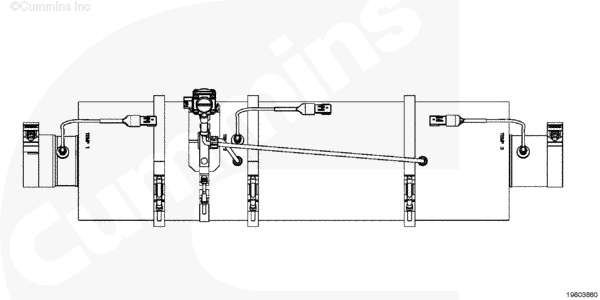 |
|
Aftertreatment Diesel Particulate Filter Differential Pressure – Data Valid but Above Normal Operational Range – Moderately Severe Level
|
Overview
| CODE | REASON | EFFECT |
| Fault Code: 1921 PID: S324 SPN: 3251 FMI: 0/16 LAMP: Amber SRT: |
Aftertreatment Diesel Particulate Filter Differential Pressure – Data Valid but Above Normal Operational Range – Moderately Severe Level. The soot load of the aftertreatment diesel particulate filter has exceeded the recommended limits. |
The aftertreatment dash lamp will flash. Engine protection derate. |
 ISX and ISM – Aftertreatment System
|
Circuit Description
The engine aftertreatment system monitors the soot load in the aftertreatment diesel particulate filter. Under normal operating conditions, the aftertreatment diesel particulate filter is self-cleaning, where soot is converted to carbon dioxide, nitrogen, and water. Under light load operating conditions, it can be necessary to perform a stationary regeneration of the aftertreatment diesel particulate filter. The soot load in the aftertreatment diesel particulate filter is estimated using the aftertreatment differential pressure sensor and the calculated soot output of the engine.
This fault code can be triggered if the application is not operating at a duty cycle high enough to actively regenerate the aftertreatment diesel particulate filter. This fault code indicates that the exhaust temperatures exiting the turbocharger are not high enough to actively regenerate the soot that is trapped in the aftertreatment diesel particulate filter. It may be necessary to increase the duty cycle of the application in order to prevent plugging of the aftertreatment diesel particulate filter.
Component Location
The aftertreatment diesel particulate filter is located in the exhaust system and is installed by the original equipment manufacturer (OEM). Refer to the OEM service manual.
Conditions for Running the Diagnostics
This diagnostic runs continuously when the engine speed is greater than 500 rpm.
Conditions for Setting the Fault Codes
The electronic control module (ECM) detects that the soot load of the aftertreatment diesel particulate filter is moderately severe. The aftertreatment system needs to be regenerated to remove the soot.
Action Taken When the Fault Code is Active
- The ECM will illuminate the amber CHECK ENGINE light immediately after the diagnostic fails.
- The ECM will flash the aftertreatment lamp immediately after the diagnostic fails.
- Torque output of the engine will be reduced as the soot load in the aftertreatment diesel particulate filter increases.
Conditions for Clearing the Fault Code
The ECM will turn off the amber CHECK ENGINE light immediately after the soot load in the aftertreatment diesel particulate filter has dropped below the moderately severe level.
Shop Talk
Verify the electronic control module (ECM) calibration is correct. Check the calibration revision history found on QuickServe™ Online for applicable fixes to the calibration stored in the ECM. If necessary, calibrate the ECM. Refer to Procedure 019-032 in Section 19.
Note: This fault code indicates that the aftertreatment diesel particulate filter requires maintenance by performing a stationary regeneration procedure. This is a maintenance procedure only and is not covered by Cummins® warranty.
Possible causes of this fault code include:
- The engine has been operating in a light load condition that prevents exhaust temperatures from being high enough to actively regenerate the aftertreatment diesel particulate filter.
- Possible engine damage that causes excessive black soot to be generated.
- The aftertreatment diesel particulate filter can accumulate an excessive amount of ash in a short time period. This can be due to excessive oil consumption or due to non-combustible elements such as, but not limited to, iron, potassium, or calcium contained in fuel additives.
If Fault Code 2777 is active along with Fault Code 1921, this indicates that a regeneration inhibit message has been received by the engine ECM and that active regeneration of the aftertreatment diesel particulate filter was not permitted. Confirm that OEM settings for the aftertreatment permit switch are configured correctly. Use INSITE™ electronic service tool to perform a stationary regeneration of the aftertreatment diesel particulate filter.
The aftertreatment diesel particulate filter soot loading can be classified into four different stages. As the soot load increases, the aftertreatment lamp and the Cummins® CHECK ENGINE (Amber) or STOP ENGINE (Red) lamp will operate according to the table below. The stationary regeneration procedure can be used to clear the soot from the aftertreatment diesel particulate filter in stages 1, 2, and 3. At level 4, the aftertreatment diesel particulate filter is completely plugged and must be inspected and cleaned; or replaced, if the aftertreatment diesel particulate filter does not meet the inspection criteria. In adequate exhaust temperatures entering the aftertreatment system can be a cause of high soot loads in the aftertreatment diesel particulate filter. The duty cycle of the application may need to be increased in order to prevent excessive soot from accumulating in the filter.
|
Soot Level Stage
|
Cummins® Fault Code
|
Aftertreatment Lamp Status
|
Cummins® Lamp Status
|
Service Procedure
|
Engine Protection Strategy
|
|
1
|
2639
|
Solid
|
Off
|
Perform stationary regeneration procedure
|
No engine protection derate
|
|
2
|
2639
|
Flashing
|
Off
|
Perform stationary regeneration procedure
|
Engine protection derate
|
|
3
|
1921
|
Flashing
|
Amber
|
Perform stationary regeneration procedure
|
Engine protection derate
|
|
4
|
1922
|
Off
|
Red
|
Inspect and clean or replace the aftertreatment diesel particulate filter
|
Severe engine protection derate
|
Refer to Troubleshooting Fault Code t05-1921
